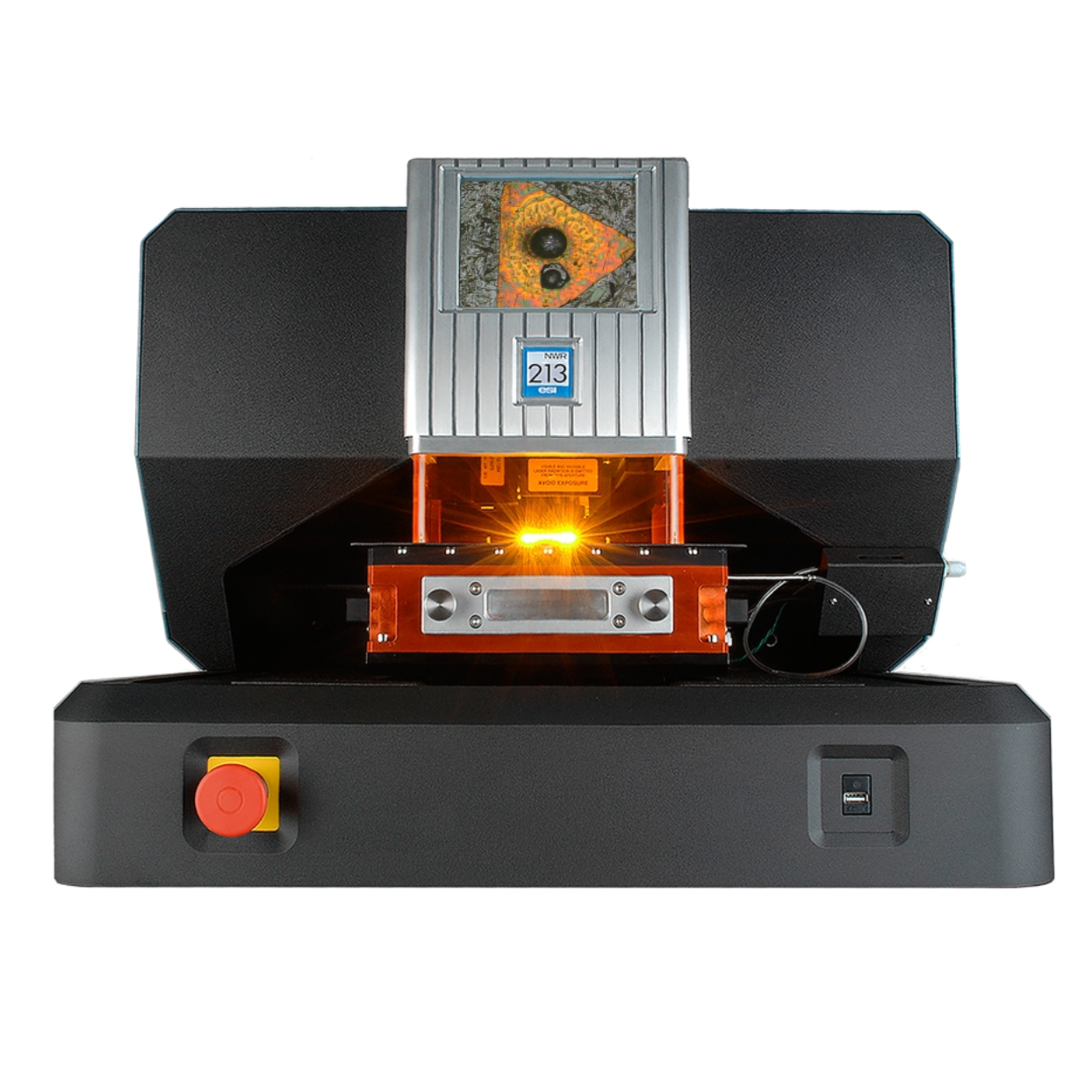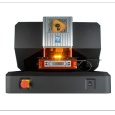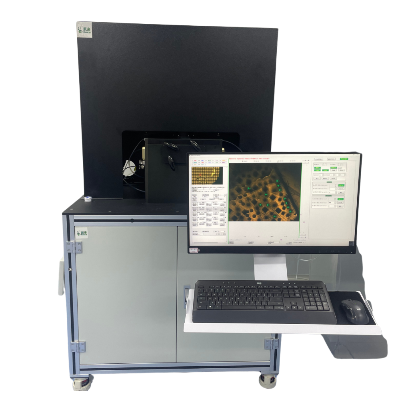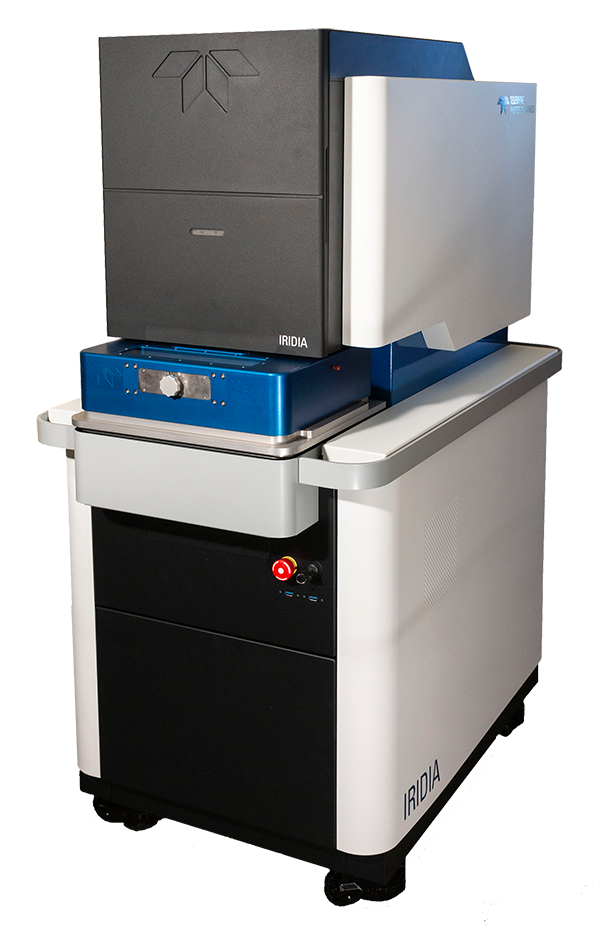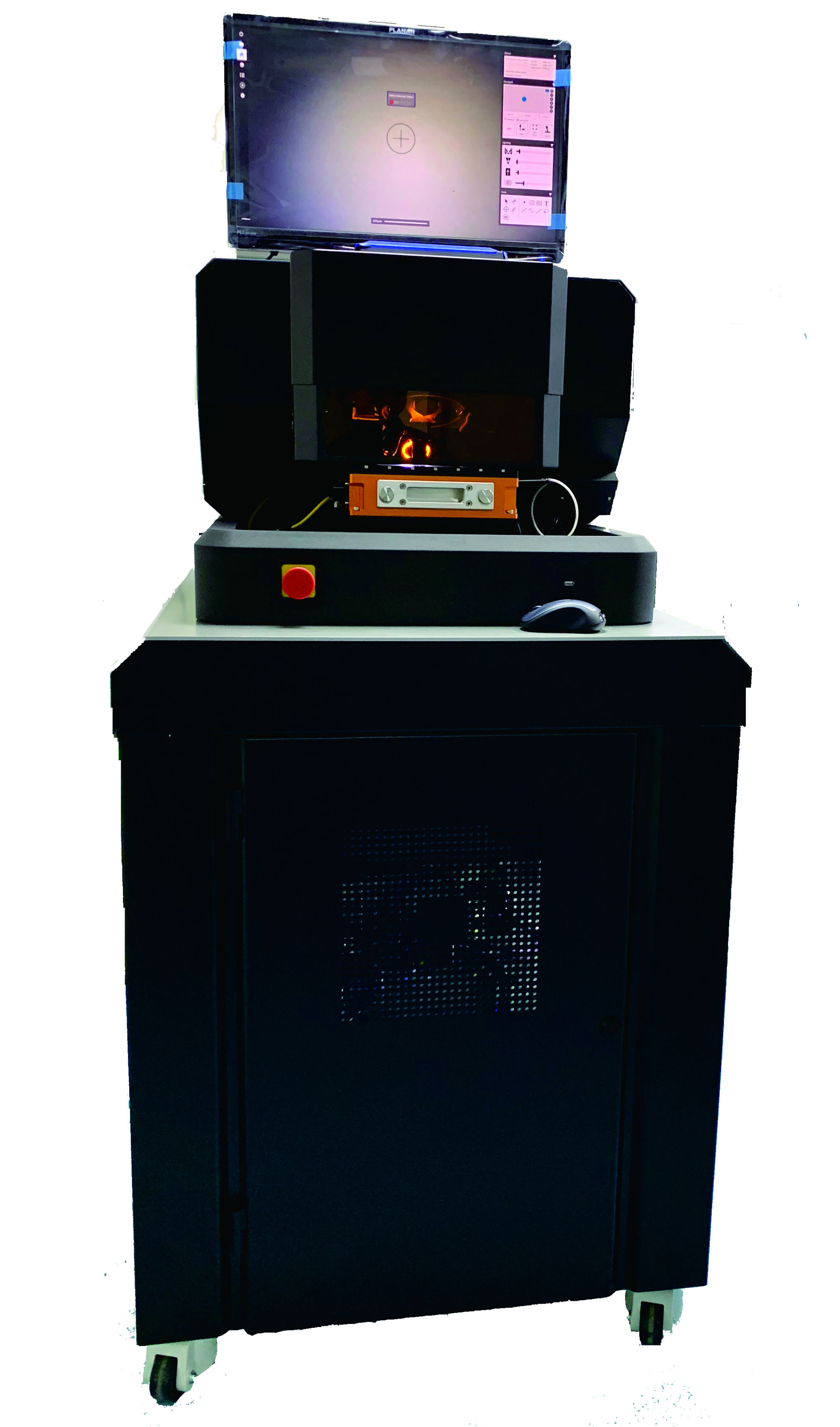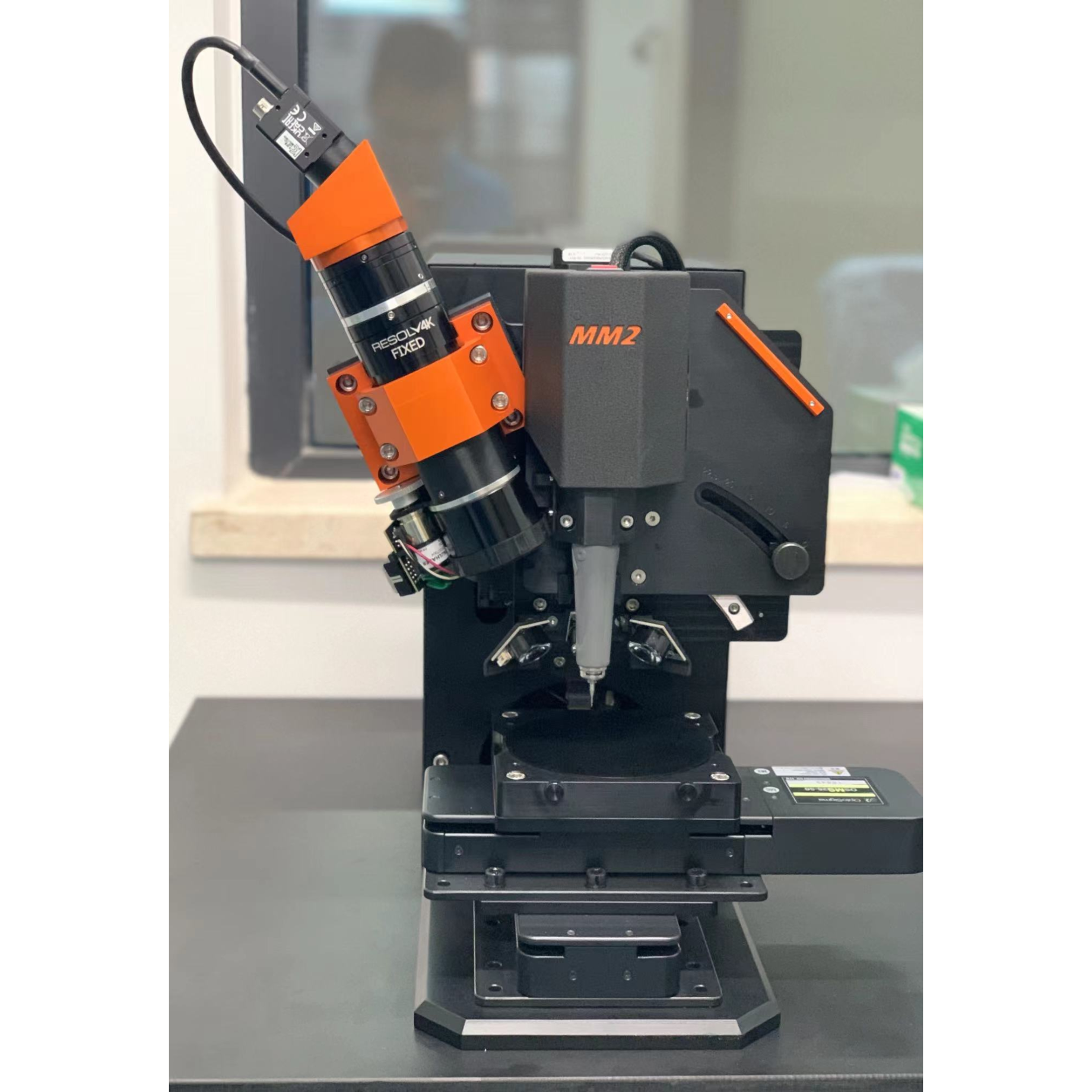方案详情
文
采用激光烧蚀-电感耦合等离子体质谱(LA-ICP-MS)、仪器中子活化分析(INAA)和x射线荧光分析(XRF)等方法,对不同生产设施采集的砖石进行取证元素组成研究。这些检查的目的是评估这些方法在砖石法医比较分析中的潜力。使用NIST标准参考材料(679、98b和97b)评价分析方法的准确性。为了进行比较,采用多元数据分析。以主成分分析(PCA)和聚类分析为例,对基于V、Na、K、Sm、U、Sc、Fe、Co、Rb和Cs浓度的INAA结果进行了评价。不同分析方法得到的结果是一致的。结果表明,所述元素分析方法是对砖石进行法医鉴定的一种有价值的工具。
方案详情

Applied Radiation and Isotopes 67 (2009)2128-2132 N. Scheid et al./ Applied Radiation and Isotopes 67 (2009) 2128-21322129 Contents lists available at ScienceDirect Applied Radiation and Isotopes journal homepage: www.elsevier.com/locate/apradiso Forensic investigation of brick stones using instrumental neutron activationanalysis (INAA), laser ablation-inductively coupled plasma-massspectrometry (LA-ICP-MS) and X-ray fluorescence analysis (XRF) Nicole Scheid a.b,*, Stefan Becker b, Marc Diicking, Gabriele Hampel, Jens Volker Kratz ,Peter Watzke ", Peter Weis , Stephan Zauner Johannes Gutenberg-University of Mainz, Institute of Nuclear Chemistry, Fritz Strassmann Weg 2, 55128 Mainz, GermanyP Federal Criminal Police Office Wiesbaden, Forensic Science Institute, KT 13-Inorganic Material Analysis, 65173 Wiesbaden, Germany A RTICLEINFO ABSTRACT Brick stones collected from different production facilities were studied for their elemental compositionsKeywords:under forensic aspects using laser ablation-inductively coupled plasma-mass spectrometryBrick stones (LA-ICP-MS), instrumental neutron activation analysis (INAA) and X-ray fluorescence analysis (XRF).Forensic analysis The aim of these examinations was to assess the potential of these methods in forensic comparisonMultivariate analysis analyses of brick stones. The accuracy of the analysis methods was evaluated using NIST standardXRF reference materials (679,98b and 97b). In order to compare the stones to each other, multivariate dataINAA analysis was used. The evaluation of the INAA results (based on the concentrations of V, Na, K, Sm, U, Sc,Fe, Co, Rb and Cs) using principal component analysis (PCA) and cluster analysis is presented as anexample. The results derived from the different analytical methods are consistent. It was shown thatelemental analysis using the described methods is a valuable tool for forensic examinations of brickstones. LA-ICP-MS ◎ 2009 Elsevier Ltd. All rights reserved. 1. Introduction In forensic investigations, building materials like brick stonescan be used as evidence to associate, e.g. one scene of crime to asuspect or to another scene of crime (see e.g. the caseworkexample in Schneck, 2007). To this end, elemental analysis can beused to characterise brick stones (or fragments of them) in orderto compare them to each other. Elemental analysis of brick stones can be applied in archaeo-metry in order to obtain information e.g. about the origin of thestones and therefore about economical relations. Neutron activa-tion analysis (e.g. Betts, 1991) and X-ray fluorescence spectro-metry (e.g. Blasius et al., 1982; Hoffmann et al., 1987) aremultielement methods frequently used for the analysis ofarchaeological brick samples. Borate fluxes are commonly appliedfor the sample preparation and homogenisation of various oxidematerials for X-ray fluorescence analysis (see e.g. Bennett andOliver, 1976). Borate fluxes have also been introduced for thesample preparation of geological materials for laser ablation-inductively coupled plasma-mass spectrometry (LA-ICP-MS)(e.g.Perkins et al., 1993; Odegard et al., 1998; Pickhardt et al., 2000; ( *Co r responding author at: Johannes Gutenberg-University of Mainz, Institute of Nuclear Chemistry, Fritz Strassmann Weg 2, 55128 Mainz, Germany. T el.: +49 613 1 3925878; fax: +49 613 1 3925253. ) ( E -mail a ddress: nicole.scheid@t-online. d e ( N . S cheid). ) ( 0969-8043/$-see front matter o 2 0 0 9 Elsevier Ltd. All rig h ts reserved. doi: 1 0. 1 016/j . a p radiso.2009.05.009 ) Giinther et al., 2001) and studies on the influence of variousinstrumental parameters on the analytical performance have beencarried out (Weis et al.,2005). In this study, the potential of elemental analysis of brick stonesin forensic examinations is assessed. Laser ablation-inductivelycoupled plasma-mass spectrometry, instrumental neutron activa-tion analysis (INAA) and X-ray fluorescence analysis (XRF) wereused for the analyses. Appropriate sample preparation methodswere applied for the respective analytical procedures, utilisingborate fusion for sample homogenisation and matrix matchingprior to XRF and LA-ICP-MS. The performance of the methods wasevaluated by analysis of several reference materials. The methodswere applied to multiple samples from one brick stone, to samplesfrom several brick stones of one production batch, to several brickstones from different producers, and to brick stones of unknownorigin. For the interpretation of the elemental concentration dataobtained, two multivariate statistical analysis methods (Henrionand Henrion, 1995) were used: cluster analysis and principalcomponent analysis. The focus of this paper lies on the resultsachieved by INAA. 2. Survey To test the ability of the three analytical methods (INAA, XRFand LA-ICP-MS) to accurately determine element concentrations in brick stones, three standard reference materials of the NationalInstitute of Standards and Technology, brick clay (NIST SRM 679),plastic clay (NIST SRM 98b) and flint clay (NIST SRM 97b), wereanalysed. INAA was performed on the reference materials withoutfurther sample preparation, while borate fusion was applied priorto XRF and LA-ICP-MS analyses. The variation of the elemental composition in a single brickwas determined. Therefore, one brick (Z4) was divided into fourparts (Z4-1a, Z4-1b, Z4-2a and Z4-2b) and samples from each ofthese parts were taken. This was in order to assess thehomogeneity of brick stones which is a prerequisite for successfulcomparative analyses of bricks. In a second step, a group of fourbricks from the same production batch were investigated andcompared to each other (Z4, which was subdivided into the foursubsamples as described above, Z1, Z2 and Z3). In a third step, brick stones from different producers wereanalysed and compared to each other (samples Z5, Z6, Z7 and Z8).Brick stone Z6 was subdivided into a sample from the red exteriormaterial (Z6r) and a sample from the black core material (Z6b).Additionally, three old brick stones from unknown producers (Z9,Z10 and Z11) and two samples from a murder case (S1, C1) wereanalysed. The aim of these examinations was to assess whether thevariability of elemental concentrations is significantly higherbetween stones from different producers than they are betweenstones from the same production batch. If this is the case, then theresults of elemental analysis of two brick stones can provideevidence for or against a hypothesis, e.g. that the two stonesoriginate from the same production batch. 3. Analytical procedure 3.1. Sample preparation procedure for LA-ICP-MS and XRF For the investigation using LA-ICP-MS and XRF, the sampleswere coarsely crushed to small pieces (diameter smaller than2 mm). Weighed portions (625 mg) of these pieces were mixedwith 87.5 wt% lithium tetraborate (99.995% grade, Sigma Aldrich, Germany) in a platinum crucible and melted using a dedicated gasfurnace (Fluxana 2MA, Kleve, Germany). For the smelting, aprogramme with a total duration of 12min and a maximumtemperature of about 1100℃ (applied for 6 min) was chosen. Theheating, agitating, pouring and cooling processes were controlledby a microprocessor. The homogeneity of the resulting glasssamples was verified by analysing four different samples at 12randomly selected locations on the surface of each sample byLA-ICP-MS (data not shown; highest relative standard deviation(RSD) for Co: 8.2%; lowest RSD for Mg: 0.9%; 80 um spot). 3.2. XRF analytical procedure The XRF measurements were performed utilising an Eagle IIu-XRF instrument (Rontgenanalytik, Taunusstein, Germany). Theinstrumental parameters were chosen as follows: Rhodium X-raytube, voltage 40kV, current 120 uA, measurement performed invacuum mode, spot size 300 um, measurement time 600 s. 3.3. LA-ICP-MS analytical procedure LA-ICP-MS measurements were performed utilising a New-Wave UP213 Laser Ablation in combination with an Agilent7500cs quadrupole ICP-MS. Laser ablation parameters: wave-length 213 nm, spot size 80 um, repetition rate 10 Hz, laser energyfluence~10J/cm², carrier gas ~1 LHe/min. ICP-MS parameters:Forward power 1390W, cool gas flow 14LAr/min, auxiliary gasflow 0.9LAr/min, additional gas flow 1LAr/min (added to thecarrier gas flow behind the ablation cell). The data acquisition (33isotopes) was performed in time resolved analysis mode, and dataevaluation was performed according to the protocol published inLongerich et al.(1996). NIST SRM 610 was digested via boratefusion in the same way as the brick samples, and the resultingborate glass was used as the calibration standard (based on theelement concentrations published in Pearce et al. (1997). Li waschosen as the internal standard. Table 1Results for the analyses (including overall uncertainty) of NIST SRM 679 (brick clay) by XRF, LA-ICP-MS and NAA. Certificate (pg/g) XRF(ug/g) Recovery XRF (%) LA-ICP-MS (ug/g) Recovery LA-ICP-MS (%) NAA(ug/g) Recovery NAA (%) Al 110100±3400 106800+2100 97.0 113500+5700 103.1 n.d. Ba 432.2±9.8 b.q. 420+40 97.2 (531.1±102.5) (122.9) Ca 1630+13 1470+100 90.1 1700+170 104.6 n.d. Ce 105 b.q. 106+10 101.0 (137.6) (130.5) Co 26a b.q. 25.4±2.5 97.7 24.2±1.5 93.1 Cr 109.7±4.9 b.q. 99+9 90.0 97.5+6.5 88.9 Cs 9.6 b.q. n.d. 10.6±0.8 110.8 Eu 1.9 b.q. n.d. 1.9+0.2 100.0 Fe 90 500+2100 90400±1800 99.9 n.d. 95600±8700 105.6 Hf 4.6 b.q. 4.1±0.5 89.1 4.8+0.4 104.3 K 24330+470 24100+500 99.2 24700+1200 101.6 29100±2800 119.7 Li 71.7±6.2 b.q. n.d. n.d. Mg 7550+88 b.q. 7070+350 93.6 n.d. Mn 1730 1600+100 92.5 1660±80 96.0 1610±106 92.8 Na 1300+38 b.q. 1470±70 112.8 1320+96 100.9 P 750 b.q. n.d. n.d. Rb 190 b.q. 184+15 96.8 173+13.8 91.0 Si 243400+3000 236400+4700 97.1 238600±10000 98.0 n.d. Sc 22.5 b.q. n.d. 26.4±1.6 117.3 Sr 73.4+2.6 b.q. 71+7 96.7 b.q. Ti 5770+330 5600+200 97.1 5530+270 95.8 5410+1350 93.7 Th 14 b.q. 13.6+1.5 97.1 12.9+1.1 92.1 Zn 150 b.q. (96±10) (63.9) 122.2+8.6 81.5 For INAA, the brick stone samples were crushed to smallpieces. To avoid loss of soluble elements, there was no cleaning of Table 2 Results (including overall uncertainty) for the analyses of NIST SRM 97b (flint clay)and NIST SRM 98b (plastic clay) by NAA. the brick stones with solvents and no further sample preparationwas applied. 3.5. INAA analytical procedure From each sample, two different irradiation programmes wereapplied to four weighed portions, respectively. Irradiation wasperformed at the research reactor TRIGA Mark II in Mainzdescribed elsewhere (Hampel et al., 2006). For each of the twoirradiation programmes, four different y-spectrometry measure-ment routines were applied. These programmes were matchedwith the different radioactive half-lives of the elements (Reus andWestmeier, 1983). During the long irradiation programme, samples of 100 mgwere irradiated in the rotary specimen rack for 6h (neutronflux 0.7×1012cm-2s-1). After a waiting time of 4 days, thesamples were measured with a high purity germanium (HPGe)semiconductor detector for one hour. The elements Na, K, Ga, As,La, Sm, Lu, W, and U were detected. The next measurementswere carried out approximately 10 days after irradiation. Now,the samples were measured for 8h and the following elementswere found: Sc, Cr, Fe, Co, Zn, Rb, Zr, Sb, Ba, Cs, Ce, Eu, Yb, Hf, Ta,and Th. For the short irradiation of 1 min, a 10 mg aliquot of eachsample was taken. This irradiation was carried out in thepneumatic specimen tube with a neutron flux of 1.6×102cm--2s-. The samples of this short irradiation were measured for10 min after a decay time of approx. 2 min. Afterwards, everysample is measured again for 30min. This measurement pro-gramme was chosen because of the overlap between the maingamma lines of manganese and magnesium ("Mg: 843.76keV;Mn: 846.75keV). The elements Ti, V, and Mn were detected inthis short irradiation programme. High purity liquid standards were used for the quantification.These standards were irradiated in the same procedures as thebrick stone samples. For data evaluation, the software Genie 2000Version 3.0 (Canberra Eurisys) was used. Table 3 Analyses (including overall uncertainty) of various brick stone samples by NAA; element concentrations used for principle component analysis and cluster analysis. Z1 (ug/g) Z2 (ug/g) Z3 (ug/g) Z4-1a (ug/g) Z4-1b(ug/g) Z4-2a(ug/g) Z4-2b(pg/g) Z5 (ug/g) V 122+11 127+8 130+9 128+19 127+18 135±11 128+16 82.2±11.4 Na 2590+176 2500+237 2600+201 2850±163 2880+188 2800±122 2700+220 9900+852 K 28200+2400 30300±2900 29400+2500 32200+2600 31100+2400 30700+2400 306002700 31100+3600 Sm 7.98+0.83 7.84+1.26 8.20+0.89 8.96+0.99 8.68+1.00 8.63+0.93 8.04+0.87 7.61±1.29 U 3.07+0.41 3.23+0.27 3.45+0.36 3.62±0.35 3.32±0.41 3.17+0.40 3.28+0.32 3.60+0.45 Sc 20.3±1.8 21.3+1.8 20.8+1.6 22.4±1.1 22.8+1.4 22.2±1.1 20.7±0.8 15.2+0.7 Fe 41300±4300 45100±4400 41900+4500 48900±4300 49400±4900 44300+5500 47000+7900 38900+3100 Co 15.8+2.5 15.6±1.6 15.0±1.4 16.6+1.2 16.6±1.8 15.6±1.9 16.6+2.2 11.8+0.5 Rb 141±10 151+18 141+12 168±14 156+10 151±12 161+20 146+9 Cs 14.2+1.1 14.2±1.4 14.9±1.3 15.3+1.0 15.9±1.0 15.6±1.2 14.8+1.4 14.6±1.3 Z6r (ug/g) Z6b (ug/g) Z7 (ug/g) Z8 (ug/g) Z9 (ug/g) Z10 (ug/g) Z11 (ug/g) C1 (ug/g) S1 (pg/g) V 104+12 115±9 164±13 94.0+11.7 132+25 148±28 164±16 131±19 116+20 Na 762±32 780+63 4460+404 5350±313 5630±213 3390+134 3530+191 5850+277 6300+256 K 16600+1400 16900±1700 30800+2700 35700+2700 35200+2800 31300+2400 28600+2400 21500+1900 20300+1800 Sm 7.19+0.78 7.29+0.80 12.6+3.4 8.09+1.33 8.09+0.87 8.62±0.91 9.51+0.98 9.57±1.01 9.31±1.07 U 4.39+0.47 4.46+0.49 4.31+0.44 4.19+0.58 4.58+0.55 2.55+0.33 3.15+0.29 6.93+0.68 5.77+0.66 Sc 17.7±1.4 17.2±1.2 22.7+2.2 16.6+0.7 17.2+0.9 19.0+0.7 20.4+1.1 16.5±1.0 15.3±0.6 Fe 27300+2600 25600±2200 52100+4600 40600+3400 43400+3600 54500+4300 53900±5400 44600±4300 38900+4600 Co 9.55+0.50 9.10±0.79 17.7±1.8 12.2+0.6 13.2+0.7 18.9+0.8 21.4±2.0 11.1±0.4 8.41+0.64 Rb 110±11 101+9 143+14 146±12 155±7 168±10 149±12 123+8 115±8 Cs 12.6±1.7 11.9±1.4 13.0+1.6 15.1±1.1 14.9±1.2 12.5+0.8 8.05+0.51 12.7±1.1 11.3±0.6 The results of the LA-ICP-MS,XRF, and INAA analyses of NISTSRM 679 (brick clay) are presented in Table 1. With XRF, only the major and minor elements Al, Ca, Fe, K, Siand Ti could be quantified; all other element concentrations werebelow the limit of quantification. The recovery for Ca and Ti(concentrations below 6000 ug/g) are 90.1 and 92.5%, respectively,while recoveries between 97% and 100% are achieved for Al, Fe,K and Si (concentrations > 20 000 pg/g). cluster analysisstandardised data, single linkage, euclidian distancesconcentrations of V, Na, K, Sm, U, Sc, Fe, Co, Rb and Cs,determined by NAA euclidian distance Fig. 1. Cluster analysis, based on elemental concentrations determined by NAA aslisted in Table 3. For LA-ICP-MS, recoveries of 89-113% were achieved for 16 ofthe 23 elements for which certified values or information values aregiven in the certificate. Li was applied as the internal standard. Cs,Eu, P and Sc were not included in the element menu. For Fe, largedeviations from the certified concentrations were observed, likelybecause of the low Fe concentration in the calibration standard andthe 40Arl’o* interference on 57Fet. Therefore, Fe was excluded fromthe element menu. For Zn, the recovery was 63.9%, which is probablythe result of vaporisation during the fusion process. With NAA, recoveries between 80% and 120% were achieved for14 elements. For the elements Li, Si, and P no isotopes emittingy-radiation are produced, and therefore these elements could notbe quantified. Sr and Ca concentrations were below the limit ofquantification. Al and Mg could not be quantified because ofnuclear reactions (28si (n,p) 28Al; 27Al (n,p)2Mg), and theaccuracy of Ba and Ce concentration values is impaired by spectralinterferences. The results for the INAA analyses of NIST SRM 98b (plastic clay)and NIST SRM 97b (flint clay) are listed in Table 2. The recoveriesare similar to those found for NIST SRM 679 (brick clay). For further statistical analysis of the INAA results, the elementsV, Na, K, Sm, U, Sc, Fe, Co, Rb and Cs were selected, taking intoaccount the signal/noise ratios of the analytical signals for theconcentrations present in the brick stones, the recovery ratesachieved in the analyses of the standard reference materials, thevariability of the concentrations in the samples from oneproduction batch (Z1, Z2, Z3, Z4-1a, Z4-1b,Z4-2a, and Z4-2b),and the variability of the concentrations in the samples fromdifferent productions (Z1, Z5, Z6r, Z7, Z8, Z9, Z10, and Z11). Theconcentrations determined for these elements by INAA analyses ofthe brick stone samples as described in Section 2 are listed inTable 3. On this data set, cluster analysis and principle componentanalysis (PCA)) were applied. Statistical calculations wereperformed using the software program Statistica 7.1 (Statsoft,Hamburg, Germany). principle component analysis (3D-plot)elemental concentrations of V, Na, K, Sm,U, Sc, Fe, Co, Rb and Cs, determined by NAA factor 2 The results of the cluster analysis are shown in Fig. 1. The bricksamples originating from the same production batch grouptogether in the first big cluster [Z1, Z2, Z3, Z4-1a, Z4-1b,Z4-2a,Z4-2b]. The samples [Z8 and Z9], [Z6r and Z6b] plus [C1 and S1]also cluster together due to ttheir similarity in elementalcomposition. The results of principal component analysis in form of a 3D-plot of the first three factors (factor 2: x-axis; factor 3: y-axis,factor 1: z-axis, displayed by coloured areas of different height)are shown in Fig. 2. In analogy to Fig. 1, the samples [Z1, Z2, Z3,Z4-1a, Z4-1b, Z4-2a and Z4-2b] lie close together in the diagram,indicating similarity of their elemental compositions. Othergroups of samples which lie close together in Fig. 2 are [Z8 andZ9],[C1 and S1] plus [Z6r and Z6b]. It would be beyond the scope of this paper to present all resultsfor the analogous examinations using LA-ICP-MS or XRF insteadof INAA, but the results are in good agreement with the INAA datapresented here (Scheid, 2008). 5. Conclusion Three different analytical methods (LA-ICP-MS, XRF, andINAA) were applied to elemental analysis of brick stone samplesin order to assess the potential of the respective methods inforensic investigations. The analysis methods were tested on NISTstandard reference materials 679,98b and 97b. The three methodsprovided accurate and reproducible concentration data for a widevariety of elements detected in the samples. The results of themeasurements were evaluated using multivariate data analysis.The results derived from the different analytical methods(LA-ICP-MS, INAA, XRF) are consistent. Of course, due to the small number of samples, this workcannot be regarded as representative for the entirety of allbrick stones. Nevertheless, in this study, the variation of theelemental concentrations between bricks originating from thesame production batch was found to be lower than the variationbetween stones originating from different producers. Therefore,elemental analysis can be applied in the forensic examination ofbricks in order to recognise similarities and differences betweenstones. Further studies regarding the improvement of the samplepreparation by using a ball mill might lead to better homogenisa-tion of the brick stone samples. Cluster analysis and principle component analysis proved to bea valuable tool for the evaluation and presentation of the resultingmultivariate data. Acknowledgement The authors would like to thank Birthe Reisse and Dr. ErikKrupicka (BKA-KT 11) for the XRF examinations, Dieter Neimke(BKA-KT 23) for assistance with the fusion furnace, and Dr. SonjaMenges (BKA-KT 5) for support concerning the statisticalevaluation of the analytical data. Additionally, we would like tothank the reviewers for their very helpful suggestions. References ( Bennett, H., Oliver, G .J., 1976. Development of fluxes for the ana l ysis of c er a mic m aterials b y X-ray fluorescencespectrometry. Analyst 101 ( 1207),803-807. ) Betts, I.M., 1991. Thin section and neutron activation analysis of brick and tile from York and surrounding areas, Recent Developments in Ceramic Petrology.British Museum Occasional Paper 81,39-55. Blasius, E., Wagner, H., Braun, H., Krumbholz, R., Thimmel, B., 1982. Archaome-trische Untersuchungen von romischen Ziegeln und Wandplatten. Fresenius Z.Anal. Chem. 310 (1-2), 98-107. Gunther, D., von Quadt, A., Wirz, R., Cousin, H., Dietrich, V.J., 2001. Elementalanalyses using laser ablation-inductively coupled plasma-mass spectrometry(LA-ICP-MS) of geological samples fused with LizB407 and calibrated withoutmatrix-matched standards. Microchimica Acta 136 (3-4),101-107. Hampel, G., Eberhardt, K., Trautmann, N., 2006. Der TRIGA Forschungsreaktor Mainz. atw internationale Zeitschrift fur Kernenergie 51 (5), 328-330.Henrion, R., Henrion, G., 1995. Multivariate Datenanalyse-Methodik und Anwendung in der Chemie und verwandten Gebieten. Springer, Berlin. Hoffmann, P., Hofmann, H., Lieser, K.H., 1987. Bestimmung von Elementen inromischen Ziegeln der Haselburg/Odw. Durch zerstorungsfreie Rontgenfluor-eszenzanalyse. Fresenius Z. Anal. Chem. 327 (5-6),530-534. Longerich, H.P., Jackson, S.E., Giinther, D., 1996. Laser ablation inductively coupledplasma mass spectrometric transient signal data acquisition and analyteconcentration calculation.J.Anal. At. Spectrom. 11 (9),899-904. Odegard, M., Dundas, S.H., Flem, B.,Grimstvedt, A., 1998. Application of a double-focusing magnetic sector inductively coupled plasma mass spectrometer withlaser ablation for the bulk analysis of rare earth elements in rocks fused withLi2B407. Fresenius J. Anal. Chem. 362 (5), 477-482. Pearce,N.J.G., Perkins, W.T., Westgate,J.A., Gorton, M.P.,1997. Acompilation of newand published major and trace element data for NIST SRM 610 and NIST SRM612 glass reference materials. Geostandards Newsl. 21, 115-144. Perkins, W.T., Pearce, N.J.G., Jeffries, T.E., 1993. Laser ablation inductively coupledplasma mass spectrometry: a new technique for the determination of traceand ultra-trace elements in silicates. Geochim. Cosmochim. Acta 57, 475-482. Pickhardt, C., Becker,J.S., Dietze, H.J., 2000. A new strategy of solution calibration inlaser ablation inductively coupled plasma mass spectrometry for multielementtrace analysis of geological samples. Fresenius J. Anal. Chem. 368 (2-3),173-181. Reus, U., Westmeier, W., 1983. Catalog of gamma rays from radioactive decay partI. At. Data Nucl. Data Tables 29 (1), 193-406. Scheid, N., 2008. Kriminaltechnische Untersuchung von Ziegelsteinen: Methoden-vergleich zwischen Laser Ablation-induktiv gekoppelte Plasma-Massenspek-trometrie, Neutronenaktivierungsanalyse und Rontgenfluoreszenzanalyse.Diploma Thesis, University of Mainz. Schneck, W.M., 2007. Forensic microanalysis: hardened concrete, bricks andengineered wood. Global Forensic Science Today 2, 8-14. Weis, P., Beck, H.P., Gunther, D., 2005. Characterizing ablation and aerosolgeneration during elemental fractionation on absorption modified lithiumtetraborate glasses using LA-ICP-MS. Anal. Bioanal. Chem. 381 (1), 212-224. 采用激光烧蚀-电感耦合等离子体质谱(LA-ICP-MS)、仪器中子活化分析(INAA)和x射线荧光分析(XRF)等方法,对不同生产设施采集的砖石进行取证元素组成研究。这些检查的目的是评估这些方法在砖石法医比较分析中的潜力。使用NIST标准参考材料(679、98b和97b)评价分析方法的准确性。为了进行比较,采用多元数据分析。以主成分分析(PCA)和聚类分析为例,对基于V、Na、K、Sm、U、Sc、Fe、Co、Rb和Cs浓度的INAA结果进行了评价。不同分析方法得到的结果是一致的。结果表明,所述元素分析方法是对砖石进行法医鉴定的一种有价值的工具。
确定
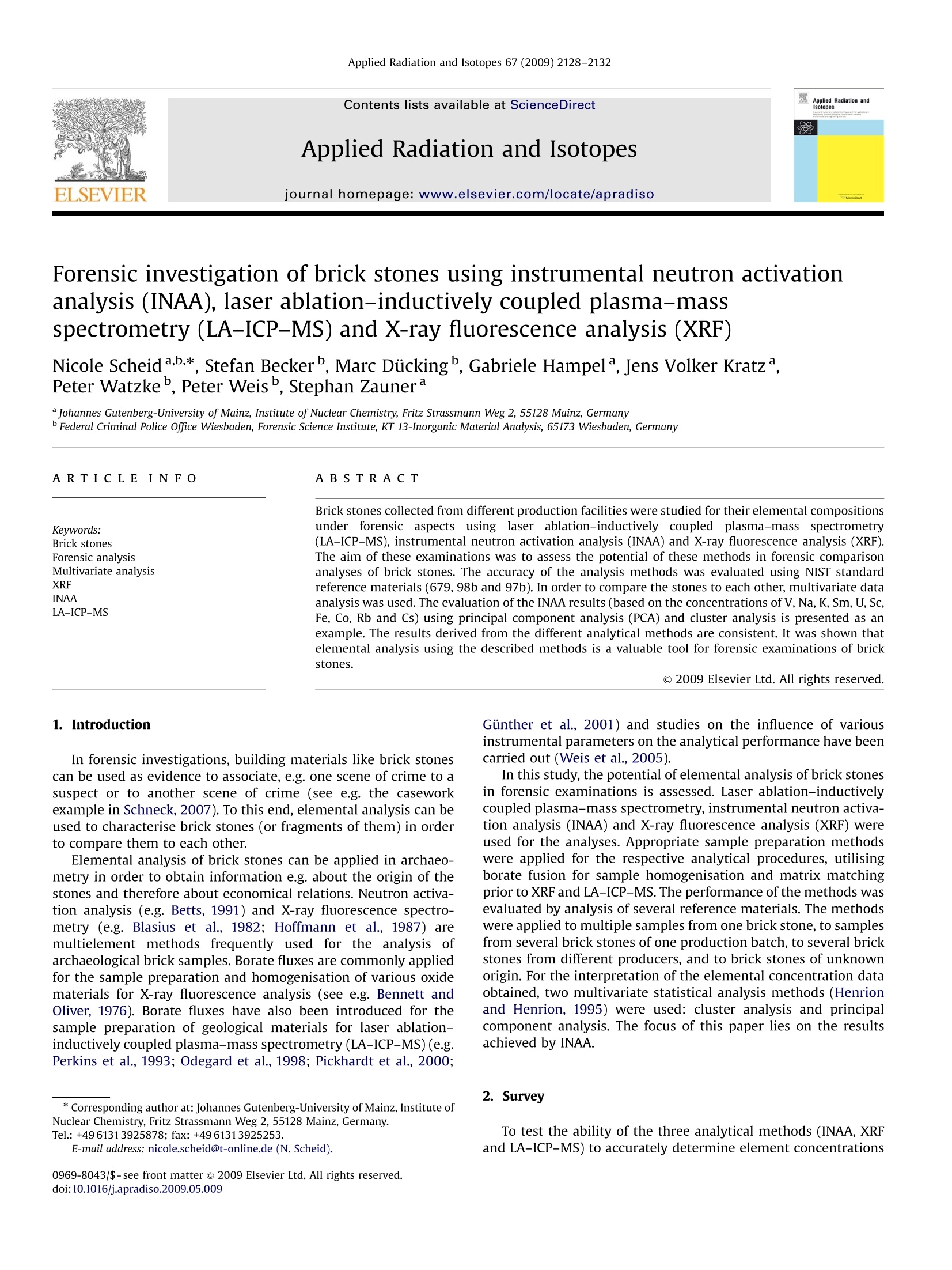

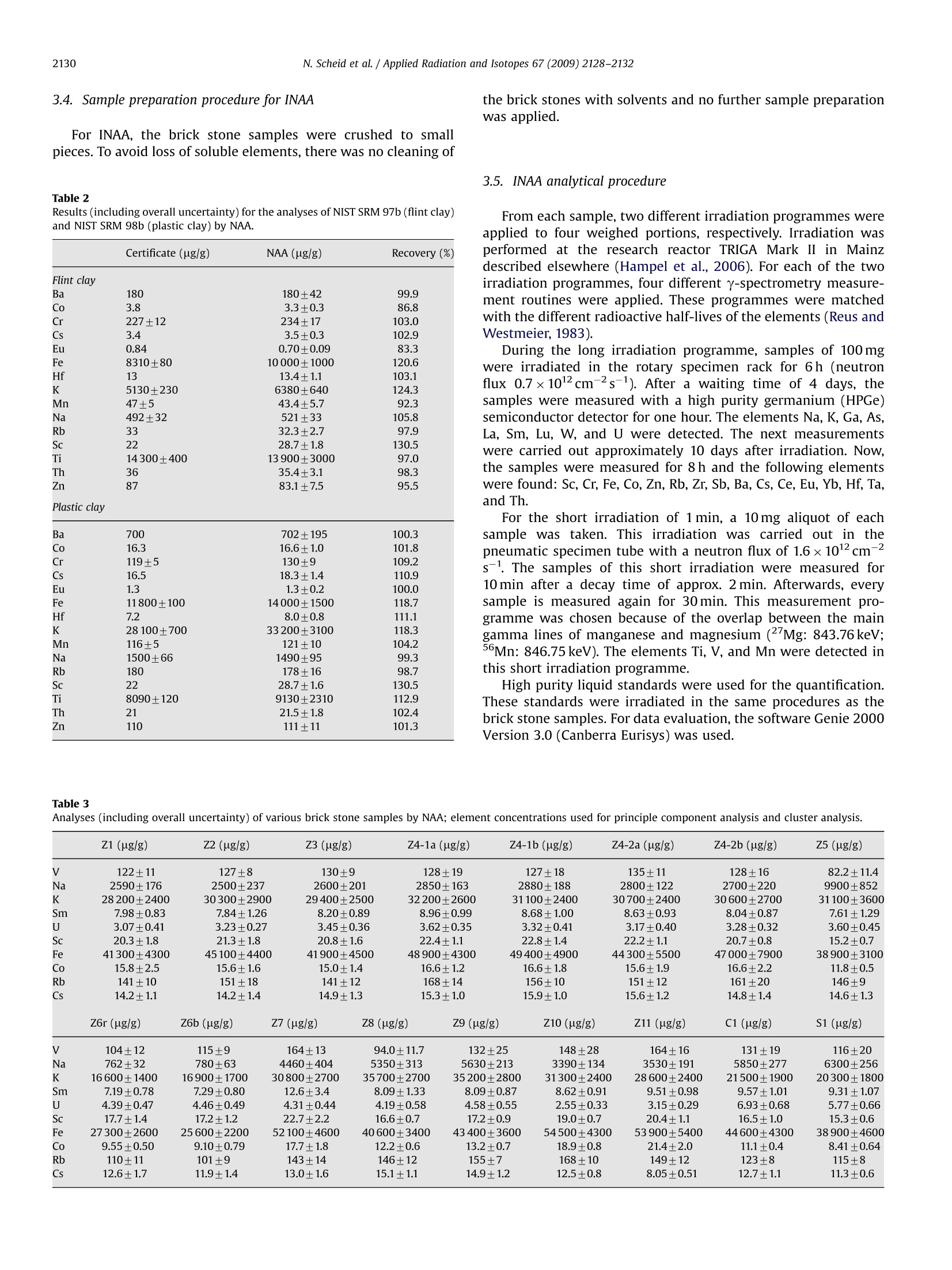

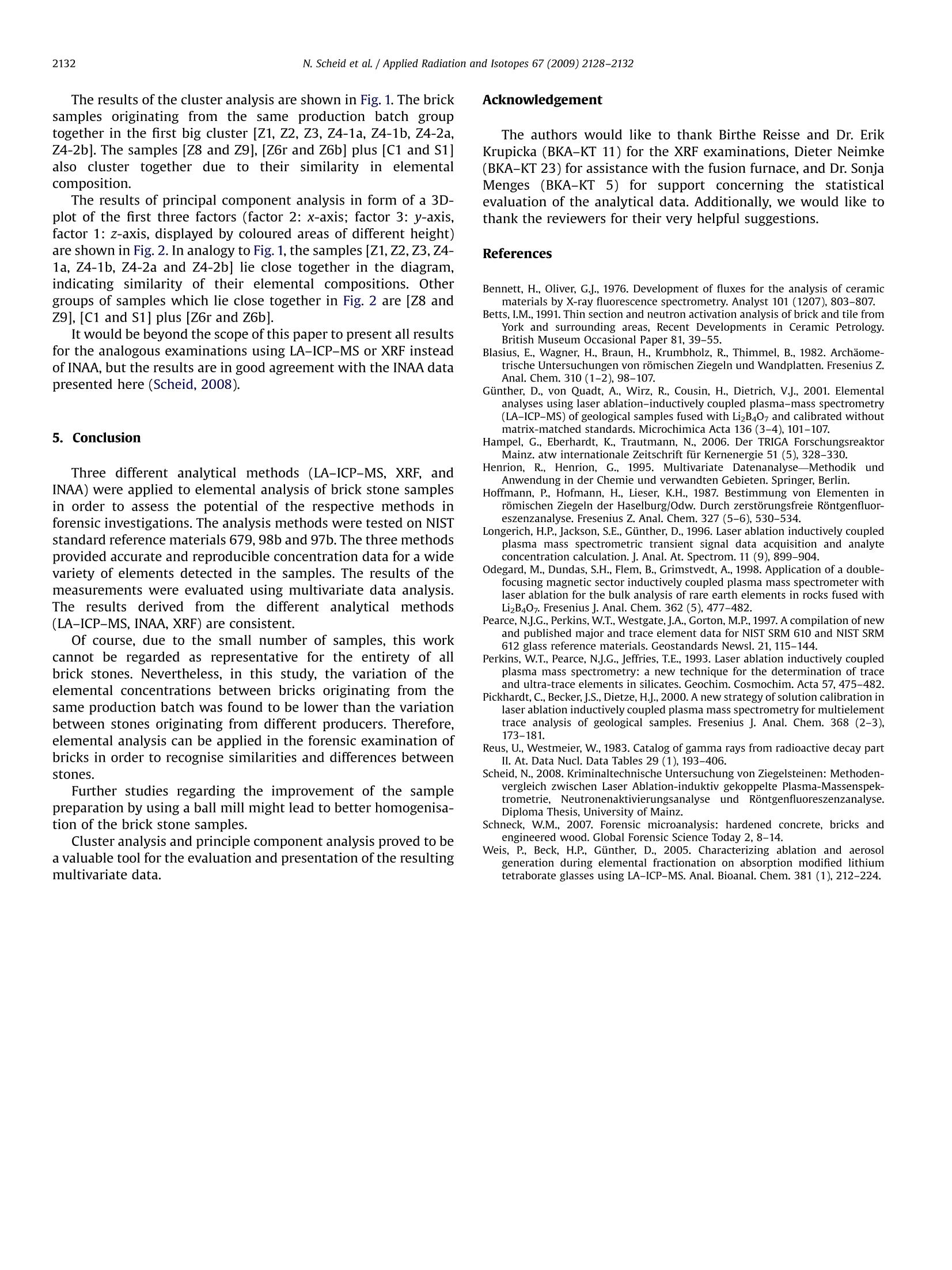
还剩3页未读,是否继续阅读?
上海凯来仪器有限公司为您提供《砖石中法医学鉴定检测方案(激光剥蚀进样)》,该方案主要用于司法鉴定中法医学鉴定检测,参考标准--,《砖石中法医学鉴定检测方案(激光剥蚀进样)》用到的仪器有ESL213 灵活的激光剥蚀系统
推荐专场
相关方案
更多

